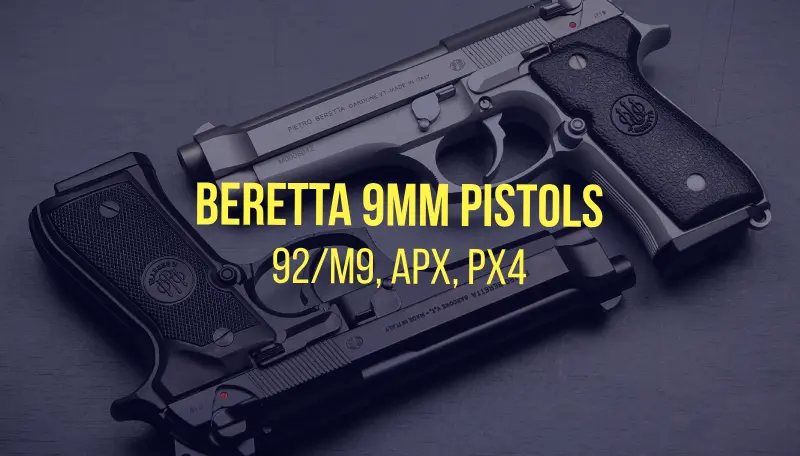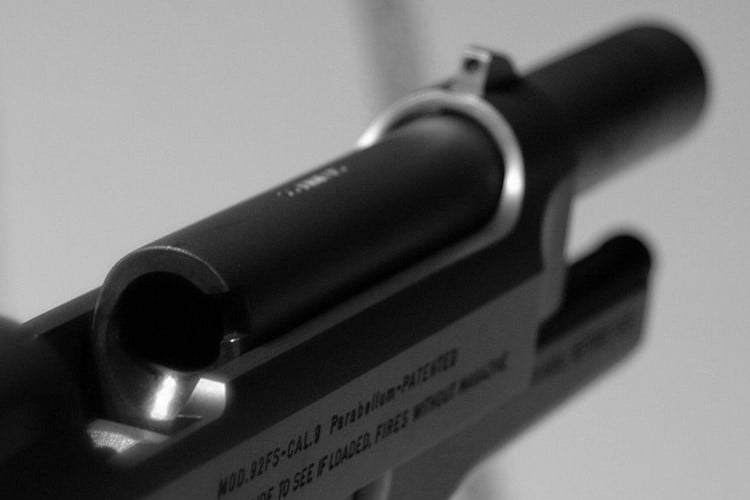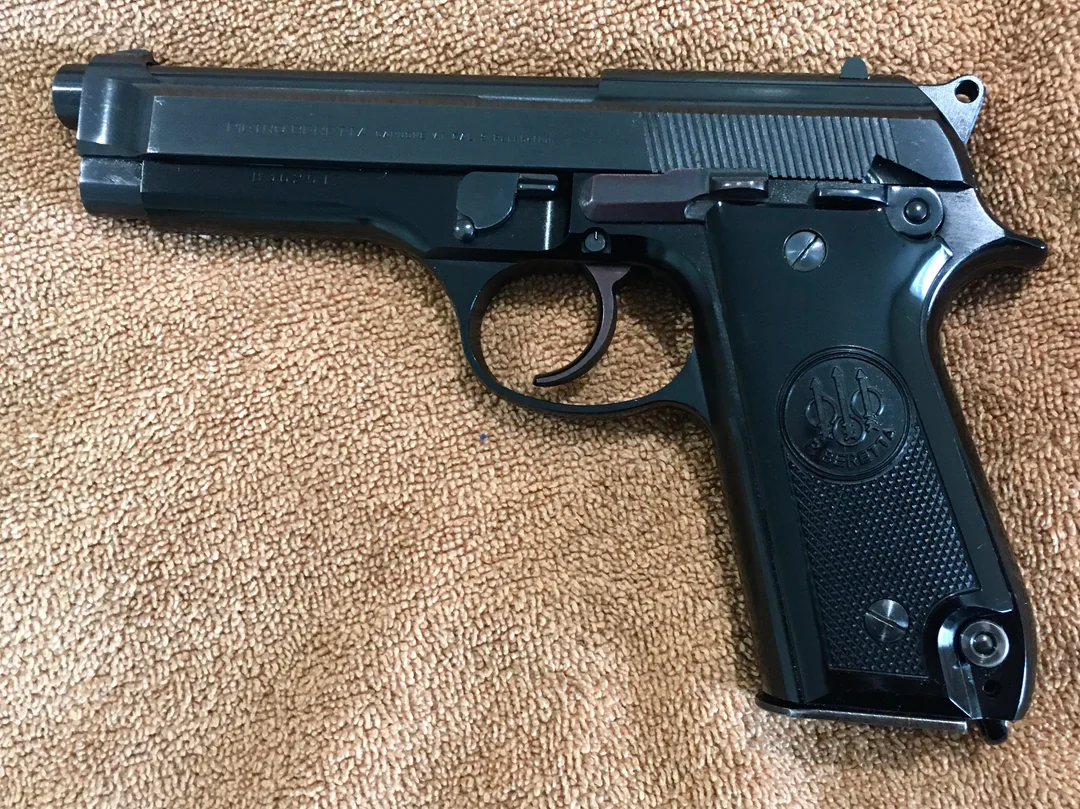
Beretta…A brand with over 500 years of firearm excellence. Originating from Italy, Beretta started off crafting gun barrels and is now known for quality and innovation in firearms. For anyone familiar with shooting sports or self-defense, Beretta’s impact on the industry is undeniable. The brand made its American debut in 1972, and just thirteen years later, a Beretta 9mm pistol was chosen to replace the iconic M1911A1 as the US military’s sidearm. So, in this post, we’ll dive into three standout Beretta 9mm pistol series: the 92/M9, APX, and PX4. Let’s get started!
Table of Contents
- Model 92: The Classic Beretta 9mm
- APX: The Striker -Fired Beretta 9mm
- PX4: The Defensive Beretta 9mm
Model 92: The Classic Beretta 9mm
The Evolution of Beretta 92
The Beretta 92 first appeared in the mid-1970s, but its real fame began after the U.S. Army adopted it in 1985. This was the era when high-capacity 9mm pistols, better known as “wondernines,” were gaining massive popularity.
 Beretta’s open slide design
Beretta’s open slide design
The original Beretta 92 took design elements from earlier models like the M1923, which featured the now iconic open slide, and the M1951. It also borrowed the locking block design from the Walther P38. The early 92 had a frame-mounted safety similar to the 1911, and a magazine release at the heel of the grip, a common feature in European pistols back then.
 The original Beretta 92
The original Beretta 92
The 92S was the next iteration, moving the safety to the slide. In the 92SB, the mag release was relocated just behind the trigger guard, making it easier to access. This model also added features like an internal firing block, ambidextrous safety levers, and 3-dot sights for better accuracy, and even had a compact version holding 13 rounds.
Then came the Beretta 92F, which replaced the Army’s aging Colt M1911 pistols. The 92F featured standardized parts for easier maintenance, a squared trigger guard, a recurved grip, and a durable hard chrome bore lining. It also sported a black finish instead of the traditional blued finish. The military version of the 92F was designated as the M9.
 Beretta 92FS
Beretta 92FS
To address a rare safety issue where slides could separate during firing, Beretta rolled out the 92FS. This model featured an enlarged hammer pin that locked into a groove on the slide, solving the problem. It turned out that the original issue was due to faulty ammunition, and not a fault of the pistol itself. Beretta ended up winning a lawsuit against the U.S. government, getting all necessary modifications funded. This updated 92FS version remains in production and is available for civilian buyers today.
Modern Variants of the 92FS and M9
Since the 92FS was introduced, Beretta has rolled out tons of different models. Some were specifically made for law enforcement, like the 92G for the French police, which skips the manual safety and uses a decocker lever instead. Even though the original 92G was discontinued, its slide design lives on in models like the M9A4.
Then there’s the 92D, a model that gets rid of both the safety and decocker lever, relying solely on a double-action trigger. In the ’90s, Beretta also introduced the 96 series chambered in .40 S&W to keep up with law enforcement trends.
 Brigadier slide
Brigadier slide
In 1993, the Brigadier-style slide came out with reinforced locking lugs for added durability and a unique “hump” in the slide’s contour. Although the extended lifespan due to this design is up for debate, many users have noted it reduces recoil and muzzle rise. Because of this, the Brigadier slide is popular in 92 variants used in action pistol competitions.
Come early 2000s, Beretta introduced the 92 Vertec. This model was designed for law enforcement and shooters with smaller hands, featuring a slim backstrap and a shorter reach trigger. It also had an accessory rail, beveled magazine well, and interchangeable front sights. Plus, it ditched the traditional barrel protrusion by shortening the barrel to 4.7 inches but kept the slide the same length.

Beretta 92 Vertec
Many modern 92 series variants blend features from both the Brigadier and Vertec models. Examples include the 92FS Brigadier, 92X, M9A3, and M9A4.
The Beretta 92X, introduced in 2019, standardizes the Vertec platform and adds the “Xtreme-S” trigger system, which cuts trigger reset by 40% and offers adjustability for pre-travel (in SAO models) and overtravel. Other highlights include a 3-slot Picatinny rail, a slimmer vertical grip, removable wrap-around grips to switch between Vertec-style and the classic M9 feel, fully removable high-visibility sights, and a universal slide allowing conversion from decocker-safety to decocker-only mode.
The series also includes the 92X Centurion (18 rd), 92X RDO Compact (15 rd) pistols, 92X Performance Carry Optic featuring an optic cut for USPSA competitors, and the lightweight 92X Performance Defensive for IDPA competitions.
New additions to the 92 family are the 92XI and 92GTS pistols. The 92XI is an SAO pistol with a 1911-style frame-mounted safety and comes in a base model, a Tactical model with a threaded barrel and DLC-coated trigger components, and a flashy Squalo edition. Meanwhile, the 92GTS is DA/SA with a twin sear and a decocker-only configuration.
Now, let’s get back to the M9. Around the mid-2000s, the US military requested some tweaks to the original design. Beretta responded with the M9A1, which borrowed features from the 92G-SD like a railed frame, standard 92 grip contour, beveled mag well, and textured grip while keeping the original M9 slide mostly the same.

Almost a decade later, Beretta rolled out the M9A3, featuring a replaceable front sight, a railed frame, and a Vertec-style backstrap with an aggressive grip texture. It also includes a wraparound rubber grip to replicate the feel of the standard M9A1 backstrap. The standout feature of the M9A3 is a redesigned slide that allows the gun to switch between FS and G configurations using a conversion kit, something that previously required an expensive and permanent modification by a gunsmith.
The latest iteration, the Beretta M9A4, boasts a red-dot optic compatible slide, dovetailed tritium night sights, an enhanced short-reset Xtreme Trigger System, 18-round sand-resistant magazines, and textured Vertec-style thin grips.

BERETTA 92 FS
Specifications:
- Action: DA/SA
- Caliber: 9mm
- Capacity: 15 rd
- Barrel Length: 4.9"

BERETTA M9A4
Specifications:
- Action: DA/SA
- Caliber: 9mm
- Capacity: 18 rd
- Barrel Length: 5.1"
The APX: The Striker-Fired Beretta 9mm
The Beretta APX series is pretty straightforward compared to the confusing variety of the Beretta 92 models. This series is a big milestone for Beretta as it’s their first venture into striker-fired pistols. Designed originally for the U.S. Armed States’ XM17 Modular Handgun System competition, the APX didn’t win but it did prove its worth by passing all the intense trials.
 Beretta APX 9mm pistol
Beretta APX 9mm pistol
In 2018, Beretta rolled out three main versions of the APX: the APX Centurion with a slightly smaller frame, the APX Compact that’s even more pocket-friendly, and the APX Combat which came with a threaded barrel and a slide ready for optics.
By 2019, Beretta made the APX more wallet-friendly, slashing the MSRP from $499 to $399. That year also saw the debut of the APX Carry – perfect for concealed carry due to its slim, single-stack magazine design.
A few months down the line, they released some cool new styles, like the flat dark earth versions of the Centurion and Compact models, and the Centurion Combat which packed a threaded barrel and optics-ready slide, just like the APX Combat. They also introduced the APX Target, which has a longer slide and barrel for better accuracy, along with some competition-ready features.
 Beretta APX A1
Beretta APX A1
Jump to 2022, and Beretta unveiled the APX A1. This new version boasts improved ergonomics with a red-dot optic-ready slide, more aggressive grip textures, and a higher undercut trigger guard. It’s got Beretta’s durable “Aqua Tech Shield” finish on the slide and barrel, a tritium front sight, and a blacked-out rear sight for better visibility. The enhanced beavertail, heavier competition recoil spring, and green competition striker mechanism from the APX Target make for a smoother trigger pull.
Safety is a big priority for Beretta too. Unlike many striker-fired pistols that require pulling the trigger for takedown, the APX features a striker deactivation button to prevent accidental discharges. Additionally, it has an automatic striker block safety and drop safety mechanism, ensuring it stays safe if dropped.
Ultimately, the Beretta APX A1 line offers a versatile range of options, including the standard full size, the APX A1 Tactical, APX A1 Compact, APX A1 Compact Tactical, and APX A1 Carry, meaning shooters have plenty of options, whether they are after a full-size pistol, something compact for concealed carry, or a competition-ready piece.

BERETTA APX A1 Carry
Specifications:
- Action: Striker-Fired
- Caliber: 9mm
- Capacity: 8 rd
- Barrel Length: 3"

BERETTA APX A1 Compact
Specifications:
- Action: Striker-Fired
- Caliber: 9mm
- Capacity: 15 rd
- Barrel Length: 3.7"
PX4 Storm: The Defensive Beretta 9mm
When talking about Beretta 9mm pistols, the PX4 might not be the first thing that comes to mind, but it’s definitely worth your attention. The PX4 series looks a little different compared to the classic Beretta 92 or the sleek APX, but every design feature is there for a reason.

Beretta 8000 Cougar and Beretta PX4 Storm
The PX4 was introduced in 2004, mainly for personal defense and law enforcement. Unlike the Beretta 92, it has a rounded trigger guard and a more rugged, stouter look.
The standard PX4 is a full-size pistol and originally came in four versions: Type F with a decocker and manual safety, Type G with just a decocker, Type C with a spurless hammer and no manual safety, and Type D with a double-action-only trigger and no hammer or manual safety. Today, you’ll mostly find the Type F. A standout feature is its rotating barrel system, which helps to reduce recoil. It’s also super easy to break down for cleaning or maintenance thanks to a disassembly latch.
With the PX4, you can swap the backstrap to fit your hand better and adjust the magazine release for lefties or righties. The frame is a lightweight polymer with steel in high-stress parts, and there’s a Picatinny rail for adding extras like lights or lasers. The three-dot sights make aiming straightforward. The pistol also uses a new slide design by Beretta intended to prevent snagging and manage the pistol from a holster. The trigger guard is also rounded for this very purpose. The slide also features ribbing along the rear and forward sections to aid in operating the assembly.
Today, the available full-size models include PX4 Storm Ful, PX4 Full-Size G-SD, which offers enhanced ergonomics and customization, and PX4 Storm SD Type F, known for its tactical features and enhanced durability for demanding environments.
 Beretta PX4, Glock 19, and Beretta 92FS
Beretta PX4, Glock 19, and Beretta 92FS
In 2008, they released the PX4 Storm Subcompact, which focused more on concealed carry, but it was discontinued in 2023. Unlike the PX4 full size and Compact, the PX4 Subcompact used a tilt barrel system and a rotating takedown pin.
Then there’s the PX4 Storm Compact, which came out in 2011 and sits between the full-size and the subcompact. It’s got a shorter slide and grip, but still uses the rotating barrel design. This version also has an ambidextrous slide stop lever and can accept full-size magazines.

PX4 Storm
The latest in the line-up is the PX4 Compact Carry 2, an upgrade from the original Compact Carry, featuring a better grip texture and a smoother trigger pull, making it a solid choice for both defense and tactical use.

BERETTA PX4 Storm Compact
Specifications:
- Action: DA/SA
- Caliber: 9mm
- Capacity: 15 rd
- Barrel Length: 3.25"
Yes, many parts are interchangeable between different models within the 92 series, especially those featuring similar frames and slide designs. However, it’s always advisable to consult the manufacturer or a gunsmith for specific compatibility information.
The Beretta M9A4 stands out with its red-dot optic compatible slide, dovetailed tritium night sights, and an enhanced short-reset Xtreme Trigger System. Compared to the M9A1, which introduced a railed frame and ergonomic improvements, and the M9A3, which added a replaceable front sight and modular grip options, the M9A4 offers further advancements in customization and performance. The M9A4’s slide can accommodate modern optics, making it ideal for competitive shooting or tactical use, and its upgraded trigger system provides a smoother, more efficient shooting experience. Additionally, the M9A4 features 18-round sand-resistant magazines and textured thin grips for improved handling.
The Beretta 92FS, known as the M9 in U.S. military service, is famed for its reliability and accuracy. It has a full-size alloy frame and a double/single-action (DA/SA) trigger system. The Beretta 92FS features a 4.9-inch barrel and an open-slide design, enhancing cycling speed and reducing the risk of jamming. Its magazine typically holds 15 rounds, with higher capacity options available. The 92FS includes fixed sights, a reversible magazine release, and an ambidextrous safety/decocker lever. Durability is another hallmark of the 92FS, with a chrome-lined barrel resisting corrosion and a non-reflective black finish for extra protection. The ergonomic grip ensures a comfortable and secure hold, aiding in precise target acquisition and control.
The Beretta APX A1 is a modern, striker-fired pistol designed for ergonomics and ease of use. It features aggressive slide serrations for enhanced grip, a modular grip frame with replaceable backstraps, and an adjustable 3-dot sight system. The APX A1 is known for its crisp trigger with a consistent pull and short reset, making it ideal for both personal defense and competitive shooting. Additionally, it comes with an accessory rail for mounting lights and lasers.
While the 92 series offers excellent reliability and performance, even the compact models tend to be quite large and may not be the best choice for concealed carry. Instead, if you prefer a double-action/single-action pistol, the Beretta PX4 Storm Compact Carry is a highly recommended option. It features a compact design, rotary barrel system to reduce recoil, and customization options like interchangeable backstraps. Alternatively, for those who prefer a striker-fired pistol, the Beretta APX A1 Compact or APX A1 Carry provide modern ergonomics, consistent trigger performance, and ease of use, making them ideal for concealed carry.
-
Gritr Sports
- June 24, 2025
Staccato HD P4: Everything You Need to Know [Review]
The Staccato HD P4 is one of the most important gun releases for 2025. This new iteration strikes a bold…
New S&W M&P 2.0 Metal Compact Pistols for EDC
- March 19, 2025
KelTec PR57: A No-Nonsense Pistol?
- February 21, 2025
A Detailed Review of Taylor’s & Co. Smoke Wagon
- February 28, 2024
Canik Mete SFT 9mm Review: The Test of Time Passed?
- February 1, 2024
Staccato 2011 P: An In-Depth Review
- January 15, 2024
The Best Browning Firearms: An In-Depth Guide
- October 26, 2023
Browning Buck Mark Practical URX Review
- October 25, 2023
The Best Revolvers of 2024: A Detailed Overview
- October 23, 2023














Leave a Reply